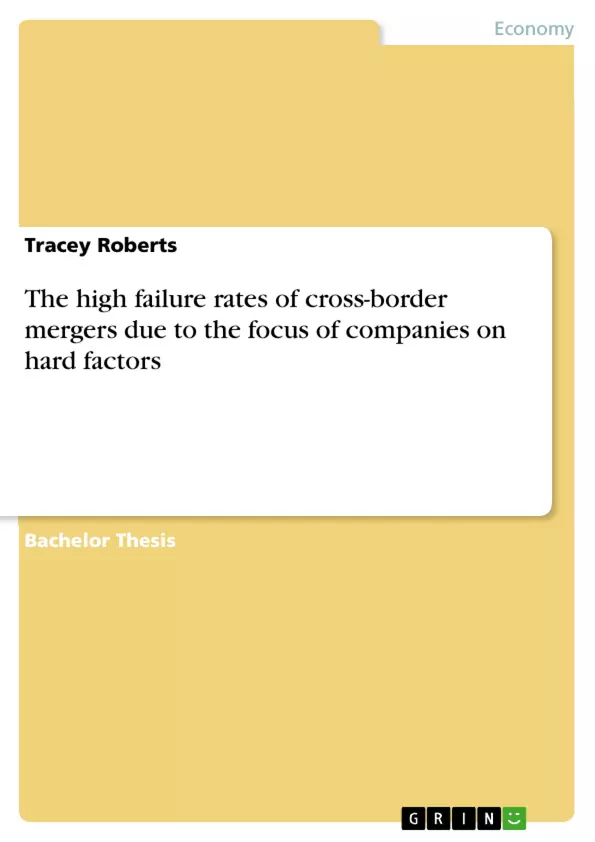In today’s economy of globalization, technological change, an increase in innovation and shorter product life cycles have led to intensified international competition. The result is an increase in productivity and capital requirements due to high R&D and growing quality costs. Cross-border mergers have become a predominant form of global expansion and a common possibility of adapting to changing market conditions (Buchner, 2002, p. 21). As the described economic development will continue and may become even stronger, the requirement for cross-border mergers exists (Gösche, 1991, p. 153). However, statistics show that the failure rate has been quite high (see p.13, 2.3).
The author will investigate critical success factors, that are often neglected and the main cause of failure. By failure the author does not mean a complete failure, but that the merged company has not achieved its expected goals. Based on preliminary research and existing knowledge, the analysis of critical success factors will mainly refer to soft factors. In cross-border mergers cultural issues in the form of organizational and national culture play an important role (Gertsen et al., Cultural Dimensions in International Mergers and Acquisitions, 1998). Furthermore, the author will focus on change management, as mergers bring along major changes that have enormous impact on managers and employees. In this context the effect of knowledge management and communication will also be analysed (Buchner, Der Mensch im Merger, 2002). As these issues will have to be considered at certain stages within the merging process, emphasis will also be laid on due diligence and the integration process (Galpin & Herndon, The Complete Guide to Mergers and Acquisitons, 2000).
Inhaltsverzeichnis (Table of Contents)
- Introduction
- Issue
- Aims and Objectives
- Literature Review
- Types of Merger
- Motives for Merging
- Rates of Failure
- Challenges of Cross-border Mergers
- Methodology
- Secondary versus Primary Data
- Quantitative and Qualitative Data
- Structure of the Dissertation
- Corus
- Company Information
- Why did British Steel and Hoogovens merge?
- Results of Corus' Merger
- Aventis
- Company Information
- Why did Hoechst and Rhône-Poulenc merge?
- Results of Aventis' Merger
- Analysis of Corus' and Aventis' Mergers
- SWOT-Analysis
- Porter's Five Forces
- In-depth Analysis of Corus' Weaknesses
- Strategy
- Dealing with Economic Threats
- Collaboration with Stakeholders
- Cultural Conflict
- Communication
- Change Management
- Critical Future Success Factors
- Personnel Development
Zielsetzung und Themenschwerpunkte (Objectives and Key Themes)
This dissertation aims to examine the success factors and challenges of cross-border mergers by focusing on two case studies: Corus (British Steel and Hoogovens) and Aventis (Hoechst and Rhône-Poulenc). The objectives of the study are to identify the key motives behind these mergers, analyze the factors that contributed to their success or failure, and provide insights into the crucial elements of successful integration.- The high failure rate of cross-border mergers
- The importance of focusing on soft factors in addition to hard factors
- The challenges of managing cultural differences and integration
- The role of effective communication and change management in cross-border mergers
- The impact of economic threats and stakeholder collaboration on merger success
Zusammenfassung der Kapitel (Chapter Summaries)
This dissertation provides an in-depth analysis of the factors contributing to the success or failure of cross-border mergers, specifically focusing on Corus and Aventis. The initial chapters delve into the theoretical framework of mergers and acquisitions, exploring various types of mergers, motives for merging, and the challenges associated with cross-border transactions. The study further examines the specific cases of Corus and Aventis, exploring the reasons behind their respective mergers and evaluating the outcomes. The latter chapters delve into a detailed analysis of Corus, utilizing SWOT analysis and Porter's Five Forces model to identify the company's strengths, weaknesses, opportunities, and threats. The dissertation further explores crucial factors such as cultural conflict, communication, and change management as they relate to Corus' merger.Schlüsselwörter (Keywords)
This dissertation focuses on the complex landscape of cross-border mergers, examining the challenges and success factors of integrating companies across national boundaries. Key themes include the high failure rate of cross-border mergers, the importance of soft factors like cultural integration and effective communication, and the impact of economic threats and stakeholder collaboration on merger success. The case studies of Corus and Aventis illustrate the complexities of these mergers, highlighting the importance of strategic planning, cultural sensitivity, and comprehensive change management strategies.- Quote paper
- Tracey Roberts (Author), 2005, The high failure rates of cross-border mergers due to the focus of companies on hard factors, Munich, GRIN Verlag, https://www.grin.com/document/137585



